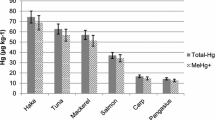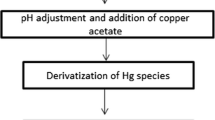Abstract
A simple and rapid procedure for measuring total mercury in fishtissues is evaluated and compared with conventional techniques.Using an automated instrument incorporating combustion, preconcentration by amalgamation with gold, and atomic absorptionspectrometry (AAS), milligram quantities of wet fish tissue wereanalyzed directly for mercury (i.e., without acid digestion). Seven tissue types (skeletal muscle, liver, blood, gonad, brain, gill, and heart) from five species (340 fish) were analyzed. Because of the small quantities of tissue needed for analysis, wedocument the homogeneity of mercury within the tissues and determine a preferred sampling technique and location for skeletal muscle. The precision was found to be generally > 10% (rsd), and the accuracy was determined by using certified reference materials (dogfish muscle, dogfish liver, and oystertissue). Comparisons to conventional cold-vapor AAS (CV-AAS) andisotope dilution inductively coupled plasma mass spectrometry found that the methods give statistically equivalent (p > 0.05) results. Because the combustion-AAS method is faster than conventional CV-AAS and produces no waste reagents, it should be particularly useful for laboratories that analyze large numbers of fish for mercury. The method detection limit for fish-muscle homogenate was estimated at 0.9 ng g-1.
Similar content being viewed by others
References
Armstrong, F. A. J.: 1979, ‘Effects of Mercury Compounds on Fish’, in J. O. Nraigu (ed.), Biogeochemistry of Mercury in the Environment, Elsevier/North-Holland Biomedical Press, New York, NY, U.S.A., pp. 657–670.
Bahnick, D., Sauer, C., Butterworth, B. and Kuehl, D. W.: 1994, ‘A national study of mercury contamination in fish’, Chemosphere 29, 537–546.
Beauchemin, D., Siu, K. W. M. and Berman, S. S.: 1988, ‘Determination of organomercury in biological reference materials by inductively coupled plasma mass spectrometry using flow injection analysis’, Anal. Chem. 60, 2587–2590.
Bloom, N. S. and Fitzgerald, W. F.: 1988, ‘Determination of volatile mercury species at the picogram level by low-temperature gas chromatography with cold-vapour atomic fluorescence detection’, Anal. Chim. Acta. 208, 151–161.
Bloom, N. S.: 1989, ‘Determination of picogram levels of methylmercury by aqueous phase ethylation, followed by cryogenic gas chromatography with cold vapour atomic fluorescence detection’, Can. J. Fish. Aquat. Sci. 46, 1131–1140.
Bloom, N. S.: 1992, ‘On the chemical form of mercury in edible fish and marine invertebrate tissue’, Can. J. Fish. Aquat. Sci. 49, 1010–1017.
Boylan, H. M. and Kingston, S.: 1998, ‘One-step mercury analysis’, American Lab. 30, 25–26.
Clarkson, T. W.: 1990, ‘Human health risks from methylmercury in fish’, Environ. Toxicol. Chem. 9, 957–961.
Clarkson, T. W.: 1992, ‘Mercury: Major issues in environmental health’, Environ. Health Perspect. 100, 31–38.
Costley, C. T., Mossop, K. F., Dean, R. J., Garden, L. M., Marshall, J. and Carroll, J.: 2000, ‘Determination of mercury in environmental and biological samples using pyrolysis atomic absorption spectrometry with gold amalgamation’, Anal. Chim. Acta. 405, 179–183.
Filippelli, M.: 1987, ‘Determination of trace amounts of inorganic and organic mercury in biological materials by graphite furnace atomic absorption spectroscopy and organic mercury speciation by gas chromatography’, Anal. Chem. 59, 116–118.
Fitzgerald, W. F. and Clarkson, T. W.: 1991, ‘Mercury and monomethylmercury: present and future concerns’, Environ. Health Perspect. 96, 159–166.
Goldstein, R. M., Brigham, M. E. and Stauffer, J. C.: 1996, ‘Comparison of mercury concentrations in liver, muscle, whole bodies, and composites of fish from the Red River of the North’, Can. J. Fish. Aquat. Sci. 53, 244–252.
Lindqvist, O.: 1991, ‘Mercury in the Swedish environment – Recent research on causes, consequences and corrective measures’, Water, Air, and Soil Pollut. 55, 1.
Pollard, J.: 2000, ‘Lake Mead fisheries contaminant biomarker survey, final report to the Nevada Division of Wildlife’, Harry Reid Center for Environmental Studies, University of Nevada Las Vegas, U.S.A., Report number HRC-F-2-4-2.
Rudner, P. C., Pavon, J. M. C. Sanchez, R. F. and Torres, A. G.: 1998, ‘Use of flow injection cold vapour generation and preconcentration on silica functionalized with methylthiosalicylate for the deternation of mercury in biological samples and sea-water by inductively coupled plasma atomic emission spectrometry’, J. Anal. Atom. Spectrom. 13, 1167–1171.
Salvato, N. and Pirola, C.: 1996, ‘Analysis of mercury traces by means of solid sample atomic absorption spectrometry’, Microchim. Acta. 123, 63–71.
Schmitt, C. J. and Brumbaugh, W. G.: 1990, ‘National contaminant biomonitoring program: concentrations of arsenic, cadmium, copper, lead, mercury, selenium, and zinc in U.S. freshwater fish, 1976–1984’, Arch. Environ. Contam. Toxicol. 19, 731–747.
Smith, R. G.: 1993, ‘Detemination of mercury in environmental samples by isotope dilution/ICPMS’, Anal. Chem. 65, 2485–2488.
Spry, D. J. and Wiener, J. G.: 1991, Metal bioavailability and toxicity to fish in low-alkalinity lakes: A critical review’, Environ. Pollut. 71, 243–304.
Thompson, D. R.: 1996, ‘Mercury in Birds and Terrestrial Mammals’, in W. N. Beyer et al.(eds), Environmental Contaminants in Wildlife – Interpreting Tissue Concentrations, Lewis Publishers, New York, NY, U.S.A., pp. 341–356.
U.S. EPA: 1991, ‘Mercury in tissues by cold vapor atomic absorption spectroscopy’, Method 245.6., U.S. Environmental Protection Agency, Washington, DC, U.S.A.
U.S. EPA: 1992, ‘Guidelines establishing test procedures for the analysis of pollutants, appendix B-definition and procedure for the determination of the method detection limit’, 40 CFR (Code of Federal Regulations), U.S. Government Printing Office, Washington, DC, U.S.A., pp. 565–567.
U.S. EPA: 1994, ‘Mercury in solid or semisolid waste (manual cold-vapor technique)’, Method 7471A. U.S. Environmental Protection Agency, Washington, DC, U.S.A.
U.S. EPA: 1998, ‘Mercury in solids and solutions by thermal decomposition, amalgamation, and atomic absorption spectrophotometry’, Draft Method 7473. U.S. Environmental Protection Agency, Washington, DC, U.S.A.
U.S. EPA: 1999, ‘Update: National listing of fish and wildlife advisories’, EPA-823-F-99-005. U.S. Environmental Protection Agency, Washington, DC, U.S.A.
Waddell, B. and May T.: 1995, ‘Selenium concentrations in the Razorback Sucker (Xyrauchen texanus): Substitution of non-lethal muscle plugs for muscle tissue in contaminant assessment’, Arch. Environ. Contam. Tox. 28, 321–326.
Watras, C. J. et al.: 1994, ‘Sources and Fates of Mercury and Methylmercury in Wisconsin Lakes’, in C. J. Watras and J. W. Huckabee (eds), Mercury Pollution Integration and Synthesis, Lewis Publishers, Chelsea, MI, U.S.A., pp. 153–177.
Webb, P. W.: 1998, ‘Swimming’, in D. H. Evans (ed.), The Physiology of Fishes, CRC Press, New York, NY, U.S.A., pp. 3–5.
Wiener, J. G. and Spry, D. J.: 1996, ‘Toxicological Significance of Mercury in Freshwater Fish’, in W. N. Beyer et al.(eds), Environmental Contaminants in Wildlife – Interpreting Tissue Concentrations, CRC Press, New York, NY, U.S.A., pp. 297–339.
Williamson, J. H.: 1992, ‘Colorado squawfish genetic survey – Tissue sampling protocol’, U.S. Fish and Wildlife Service, Denver Federal Center, Denver, CO, U.S.A.
Wren, C. D.: 1986, ‘A review of metal accumulation and toxicity in wild mammals: mercury’, Environ. Res. 40, 210–244.
Zhu, L., Lu, J. and Le, X. C.: 1993, ‘Determination of mercury in environmental and biological samples by cold vapour atomic absorption spectrometry’, Mikrochim. Acta. 111, 207–213.
Author information
Authors and Affiliations
Corresponding author
Rights and permissions
About this article
Cite this article
Cizdziel, J.V., Hinners, T.A. & Heithmar, E.M. Determination of Total Mercury in Fish Tissues using Combustion Atomic Absorption Spectrometry with Gold Amalgamation. Water, Air, & Soil Pollution 135, 355–370 (2002). https://doi.org/10.1023/A:1014798012212
Issue Date:
DOI: https://doi.org/10.1023/A:1014798012212




